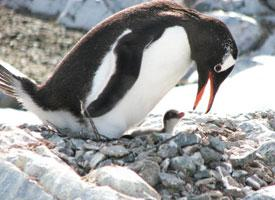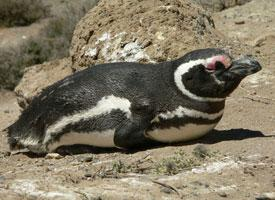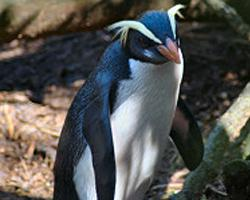
Súlyok és méretek
| Marmagasság | 55 cm |
|---|---|
| Súly | 2,5 kg |
Biológiai adatok
| Élettartam | 10 r |
|---|
Veszélyeztetettség
| Veszélyeztetett |
Állatleírás
The Southern Rockhopper Penguin (Eudyptes chrysocome) is a distinctive and charismatic species of penguin known for its unique appearance and dynamic behavior. This species is one of the smaller penguins, standing approximately 55 to 58 cm tall and weighing around 2.5 to 3.5 kg. What sets the Southern Rockhopper apart from other penguins is its striking plumage. It sports a black back and a white belly, typical of penguins, but its head is adorned with vivid yellow and black feathers. The most eye-catching features are the thin yellow eyebrows that extend behind the eyes and the red eyes themselves, which add a touch of intensity to its gaze.The Southern Rockhopper Penguin is aptly named for its habitat preferences and its distinctive manner of locomotion. Unlike other penguin species that waddle, rockhoppers are known for their ability to hop over rocks and rugged terrain, a skill that allows them to navigate the challenging shorelines of the sub-Antarctic islands where they breed and live. These islands, scattered across the southern oceans, provide the rocky beaches and cliffs that rockhoppers use for nesting sites.
Breeding is a significant part of the Southern Rockhopper Penguin's life cycle, with colonies forming dense aggregations on steep slopes and cliffs. They are monogamous birds, often forming long-term pair bonds. The breeding season begins with elaborate courtship displays, including mutual preening, head shaking, and vocalizations that strengthen the pair's bond. The female typically lays two eggs, but usually, only the second, larger egg will be successfully raised to fledging. Both parents share the responsibilities of incubation and feeding the chick, demonstrating a high degree of parental care which is essential for the chick's survival in the harsh sub-Antarctic environment.
The diet of the Southern Rockhopper Penguin primarily consists of krill, squid, and small fish. They are excellent divers, capable of reaching depths of over 100 meters in search of food, although most of their foraging occurs within the top 30 meters of the ocean's surface.
Despite their resilience and adaptability, Southern Rockhopper Penguins face significant threats from climate change, pollution, and overfishing, which impact their food sources. Additionally, their breeding sites are vulnerable to human disturbance and introduced predators. These factors have led to a decline in their population, prompting conservation efforts to protect these unique birds and their habitat.
The Southern Rockhopper Penguin plays a crucial role in the marine ecosystem, serving as both predator and prey. Their foraging activities help regulate the populations of their prey species, and they themselves are an important source of food for marine predators. Their presence also contributes to the nutrient cycle, as their guano enriches the soil in their breeding areas, supporting terrestrial ecosystems.
In summary, the Southern Rockhopper Penguin is a fascinating and resilient species, characterized by its distinctive appearance, remarkable hopping ability, and complex social behaviors. Despite facing numerous challenges, these penguins continue to thrive in the harsh environments of the southern oceans, captivating the imagination of all who are fortunate enough to observe them in the wild.
Hasonló állatok
Új állatfotók
Top 10 állat
- Dolphin gull (Leucophaeus scoresbii)
- Japanese macaque (Macaca fuscata)
- Stone loach (Barbatula barbatula)
- Russian tortoise (Testudo horsfieldii)
- Galápagos tortoise (Geochelone nigra complex)
- Greek tortoise (Testudo graeca)
- Diana monkey (Cercopithecus diana)
- Moustached guenon (Cercopithecus cephus)
- Common flying dragon (Draco volans)
- Galápagos penguin (Spheniscus mendiculus)


